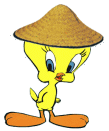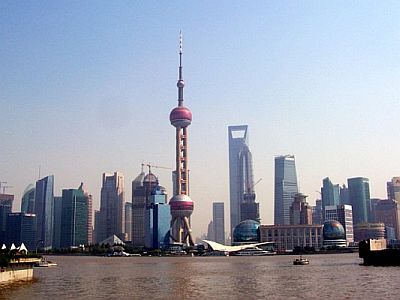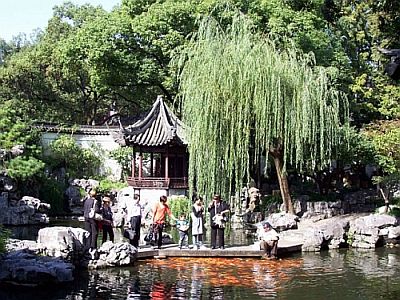
China
Shanghai, "Paris of the East"
Still a small fishing village in the 18th century, Shanghai (nicknamed "Paris of the East")
began to welcome foreign concessions (British, French and American) after
first Opium War.
The Japanese also settled there. This foreign presence traded and
attracted international banks which set up their headquarters along the bund.
![]() opium wars
opium wars
About the first Opium War
It took place between 1839 and 1842. It was a trade war on opium because the Chinese wanted to end this "trade"
with the British (whom had productions in India). The Chinese only used opium as an analgesic (painkiller ) until the 17th century...
This war is considered to be the starting point of the fall of the Empire of China, who could not militarily resist
to the British and later to the Western coalition (British, French and Russian).
It was during the first Opium War that British seized Hong Kong. This territory became
a British protectorate until the retrocession to China in 1997.
Note : In 1898, a treaty (called the second convention of Beijing) granted a lease of 99 years to UK
over new territories in order to extend Hong Kong. In 1984, the British agreed to give Hong Kong back to China
at the same time as the "new territories" provided that Hong Kong has an autonomy for 50 years.
About the second Opium War
It took place between 1856 and 1860 and was triggered by the arrest of a smuggler English ship. The
Convention of Beijing, which marks the end of the war granted concessions or territories to United Kingdom, France and
Russia, which "benefits" of this war waged by the two other Western nations.
Its name was assigned by analogy to the first war between Britain and China.
Note : The Summer Palace in Beijing was burned during the war.
Shanghai later became the cradle of Chinese Communism in 1921. Afterwards, from the 80s, it became the Chinese city whith the fastest modernization as well as a typical example of "capitalist communism" (so to speak). It is also the city where Tintin struggled against a gang of drug smugglers in the comic strip "blue lotus" (by Herg├ę)...
Pudong

This is the modern financial center of Shanghai with the highest telecommunication tower in the world (in 2009) : the pearl of Orient which reaches 468 m (1535 feet). It is often used to symbolize the city, but there are other towers in Pudong : Jinmao tower, for instance, is 420.50 m (1380 feet) high i.e. about 100 m (328 feet) higher than the Eiffel Tower and it has 88 floors. This number of floors was chosen because the figure 8 is a symbol of perfection in China. Let's mention also the World Financial Center, the highest tower in Shanghai, which culminates at 490 m (1608 feet) ! It looks like it has a handle on the top !...
From the bund, we can reach it by trolley through the "sightseeing" tunnel. Light beams make the journey more attractive.
The bund
It's a nice walk along the Huangpu (except I was unlucky to be there during works for the expo. 2010) bordered on one side by several apartments and banks headquarters.
People's square
This is the great square of Shanghai with a small adjacent park. The main shopping street of Nanjing taken on the east leads to the bund.
Yuyuan garden (or Yu garden)

This garden from the 16th century is one of the most beautiful gardens of China with those of Suzhou. It was built by Pan Yuduan, governor of the Sichuan Province, to please his father. This is the filial piety of Confucianism. About the garden, I mainly keep in mind the undulations of dragons on the walls, the zigzag of its covered bridge which could then retain the evil spirits, the big fishes, and the feeling of being in a small rockery maze. Chinese gardens are designed to represent the world in miniature, with water to symbolize rivers and sea, and rocks to symbolize mountains. The round doorways evoke harmony and the decorations of windows create a "living picture". Also to be seen are the "relic of granite" of emperor Huizong and the theater.
Near the garden there are the beautiful lotus pool (here is a nice place to take a picture) and a large shopping mall with buildings of traditional form.
Jade buddha temple (or Yufo Si temple)
It is the largest Buddhist temple in Shanghai. It was built from 1911 to 1918 to shelter a seated white jade Buddha brought from the former Burma (Myanmar) by a monk in 1882. It measures 1.95 m (2.13 feet), weighs 3 T (6,600 pounds) and is decorated with precious stones (emeralds and agates). There is also a replica of a second Buddha, reclining this one, coming from Singapore.
The windows are made of the pattern of svatiska which is repeated several times. The svatiska is a symbol of Buddhism coming from India and it represents the movement, as the wheel of law.
There are many souvenir shops in this temple and so although there are still monks (of the Zen School) and believers, I didn't feel the same contemplation as in other temples... However, there are still many devotions, the incense burns and many prayers ribbons are hung at the windows or at the entrances.
Finally, for history, the temple would have been saved from devastation during the Communist Revolution by a monk who would have covered the walls and entrance doors by portraits of Mao...
Confucius temple
It was rebuilt after its destruction in 1856 during an attack of the imperial army against a secret society. It houses a place
of Confucian worship and a school. ![]() Confucianism
Confucianism
The tradition called "Confucian" started in China several centuries before Confucius. The latter (in the 5th century B.C.) improved the tradition and gave instruction to several disciples. He sought social harmony (with respect between people and benevolent rulers) through 3 basic social relationships :
- ruler / subject relations
- Parent / Children relations : filial piety is very important in Confucianism
- husband / wife relations
The result is a hierarchy of relations.
One of the ideals of Confucianism is also to promote a bureaucracy composed of virtuous officials. The
studies have an important place in Confucianism ("study" is the first character
of the works of Confucius). Ethical behavior is based on the "li" which is the label, ritual, and
"Ren" which is humanity, benevolence.
However there are, as here, temples dedicated to Confucius, with gods unique to Confucianism.
The five cardinal virtues of Confucianism are :
- benevolence (ren)
- propriety (li)
- justice (yi)
- honesty (xin)
- faithfulness (zhong)
Among the sacred books, let's name the sayings of Confucius (actually, Confucius didn't write a single book. This was done by his disciples).
Let's also include some quotes attributed to Confucius :
- Our greatest glory is not in never falling, but in getting up every time we do.
- Forget injuries, never forget kindnesses.
- It does not matter how slowly you go so long as you do not stop.
- Respect yourself and others will respect you.
...See link : http://www.quotationspage.com/quotes/Confucius/
Note : Confucius has not been deified. In Confucianism, deceased become spirits to whom people must pay tribute.
Note : Confucius' life is linked to a mythical beast, the qilin (see Beijing - Ming tombs).
A qilin, harbinger of good omens, appeared to his mother, who was then carrying him in her womb. Another one was
killed two years before the death of Confucius, who thus lost hope for a better world...
Ohel Moishe synagogue
Many Jewish refugees from Russia settled in Shanghai in the '30s but it was mostly the asylum offered by the city, following the intervention of the Japanese vice-consul Shibota (part of China was then under Japanese occupation), during the Second World War that led persecuted Jews to settle in Shanghai. The synagogue is also a museum of that period.
More visits
-
St.Ignatius cathedral : it was built between 1905 and 1910 by French Jesuit missionaries. It is dedicated to St.Ignatius Loyola, the founder of the Jesuit order (or Society of Jesus) in 1540. Christianity appeared for a short time in China with the Nestorians in the 7th century as proven by a stele in Xi'an. The Christian faith grew with the Jesuit Mateo Ricci who arrived in China in the 16th century although a Franciscan mission had been present under the Mongol dynasty in the 13th century. There are around 50 million Christians in China, which is low compared to the population but not that low considering the restrictions of worship.
-
Former French concession : after the treaty of Nanking that ended the first Opium War, China conceded three concessions of its territory to Americans, British and French. The French concession of Shanghai was the smallest and remained under French administration from 1849 to 1946.
-
Maglev : this fast sustension magnetic train connects the airport to a subway station in Shanghai (Longyang Road - Line 2) in less than 10 minutes. The top speed is either 330 km/h (205 mph) or 400 km/h (248 mph) depending on the time. One can get a discount by showing a plane ticket.
